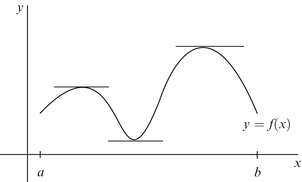Mar 25, 2013 Rolles is a special case, where the endpoints have the same y coordinate, so the tangent and chord are horizontal. F(x) = x^3 − x^2 − 20x + 6, 0, 5 f(0)= 6; f(5)= 125-25-100+6= 6. So Rolles thm applies: for (0,6) and (5,6) there must be a value,c, between 0 and 5, where the slope is zero. Y' = 3x^2 -2x -20= 0. Rolle’s theorem essentially states that any real-valued differential function that attains equal values at two distinct points on it, must have at least one stationary point somewhere in between them, that is a point where the first derivative (the slope of the tangent line to the graph of a function) is zero.
Example 2

Suppose $$f(x) = 6+5x-3x^2$$ over $$[-2,b]$$. Find the value of $$b$$ so that the Mean Value Theorem is satisfied at $$x = 1$$.
Step 1Find $$f'(1)$$.
$$ begin{align*} f'(x) & = 5 - 6x f'(1) & = 5-6(1) = -1 end{align*} $$
Step 2
Find the slope of the secant line connecting the endpoints of the interval.
$$ begin{align*} m & = frac{f(b)-f(-2)}{b - (-2)}[6pt] & = frac{6 + 5b - 3b^2 - (6 + 5(-2) - 3(-2)^2)}{b - (-2)}[6pt] & = frac{6 + 5b - 3b^2 - (-16)}{b + 2}[6pt] & = frac{22 + 5b - 3b^2}{b + 2} end{align*} $$
Step 3Determine the value(s) of $$b$$ where the value of the slope found in step 2 is equal to the derivative value found in step 1.
$$ begin{align*} frac{22 + 5b - 3b^2}{b + 2} & = -1[6pt] 22 + 5b - 3b^2 & = -1(b+2)[6pt] 22 + 5b - 3b^2 & = -b-2[6pt] 24 + 6b - 3b^2 & = 0[6pt] 3b^2 - 6b - 24 & = 0[6pt] b^2 - 2b - 8 & = 0[6pt] (b-4)(b+2) & = 0[6pt] b = 4 & quad b = -2 end{align*} $$
We already know the left-hand value of the interval is $$x=-2$$, so the right-hand value is $$x = 4$$.
AnswerWe can use the interval $$displaystyle left[-2, 4right]$$.

For reference, below is the graph of the function, the secant line and the tangent line at $$x=1$$.
Example 2
Suppose $$f(x) = 6+5x-3x^2$$ over $$[-2,b]$$. Find the value of $$b$$ so that the Mean Value Theorem is satisfied at $$x = 1$$.
Step 1Find $$f'(1)$$.
$$ begin{align*} f'(x) & = 5 - 6x f'(1) & = 5-6(1) = -1 end{align*} $$
Step 2Find the slope of the secant line connecting the endpoints of the interval.
$$ begin{align*} m & = frac{f(b)-f(-2)}{b - (-2)}[6pt] & = frac{6 + 5b - 3b^2 - (6 + 5(-2) - 3(-2)^2)}{b - (-2)}[6pt] & = frac{6 + 5b - 3b^2 - (-16)}{b + 2}[6pt] & = frac{22 + 5b - 3b^2}{b + 2} end{align*} $$
Step 35.2 Rolle's Theorem & Mvtap Calculus Calculator
Determine the value(s) of $$b$$ where the value of the slope found in step 2 is equal to the derivative value found in step 1.
$$ begin{align*} frac{22 + 5b - 3b^2}{b + 2} & = -1[6pt] 22 + 5b - 3b^2 & = -1(b+2)[6pt] 22 + 5b - 3b^2 & = -b-2[6pt] 24 + 6b - 3b^2 & = 0[6pt] 3b^2 - 6b - 24 & = 0[6pt] b^2 - 2b - 8 & = 0[6pt] (b-4)(b+2) & = 0[6pt] b = 4 & quad b = -2 end{align*} $$
5.2 Rolle's Theorem Calculator
We already know the left-hand value of the interval is $$x=-2$$, so the right-hand value is $$x = 4$$.
Answer
We can use the interval $$displaystyle left[-2, 4right]$$.

Rolle's Theorem Proof
For reference, below is the graph of the function, the secant line and the tangent line at $$x=1$$.
